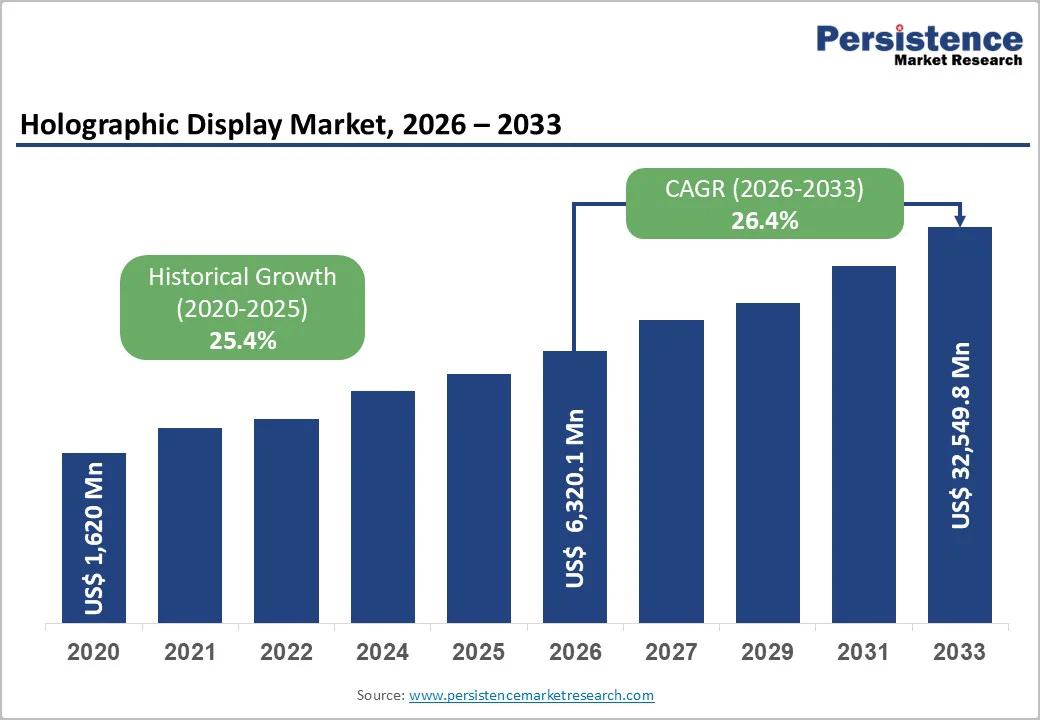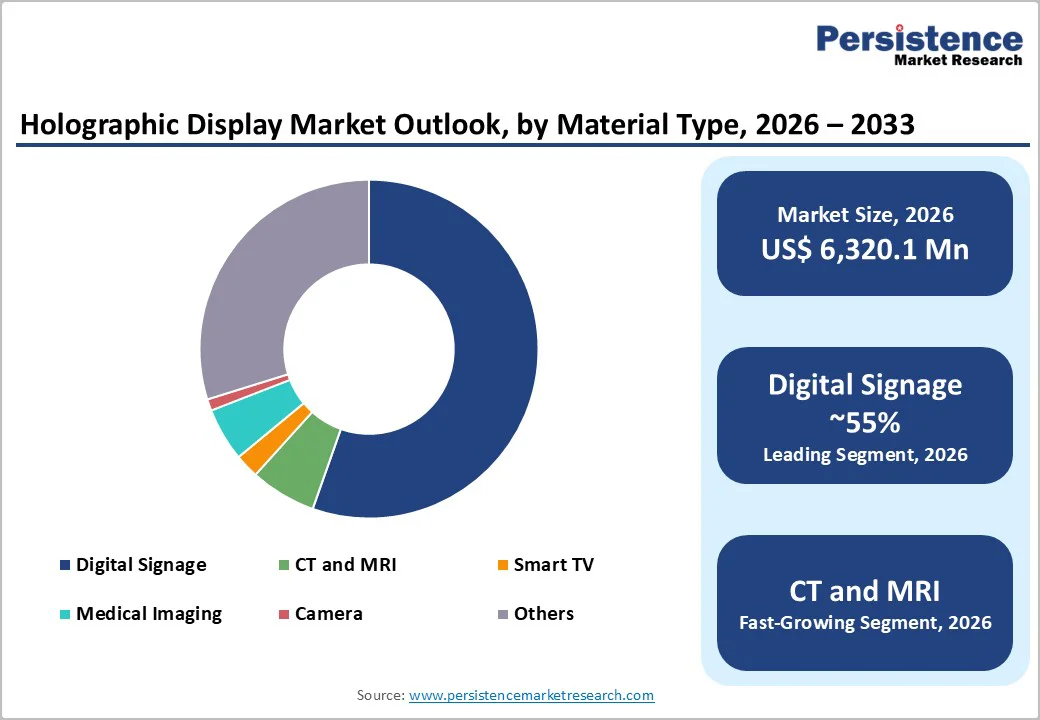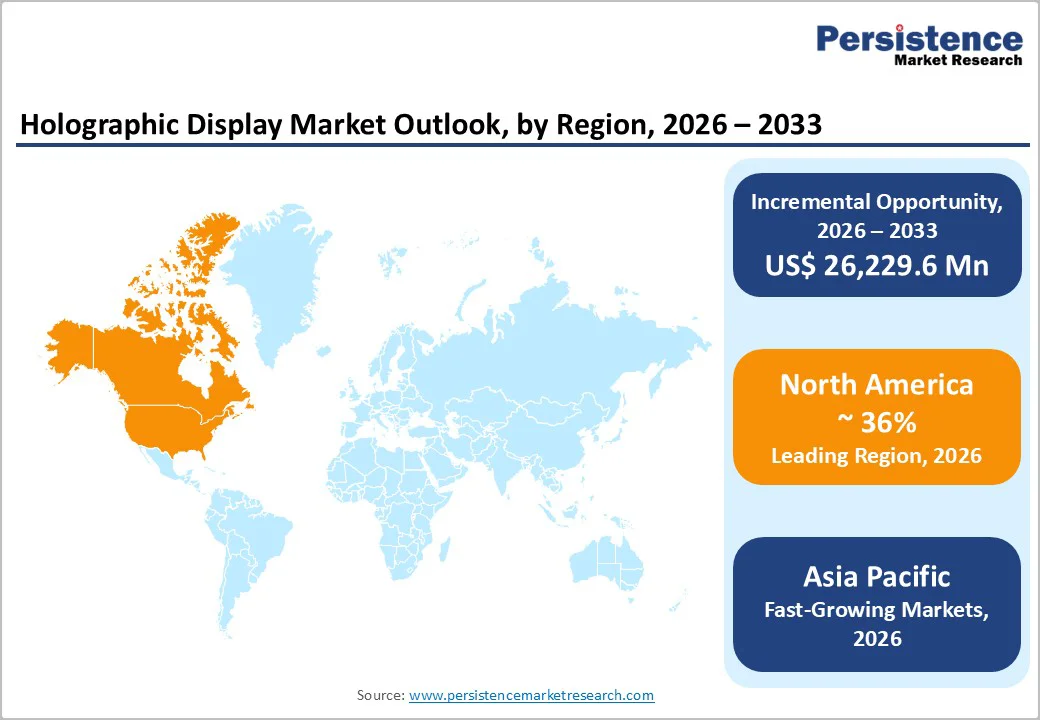ID: PMRREP33414| 199 Pages | 22 Dec 2025 | Format: PDF, Excel, PPT* | Semiconductor Electronics

The global holographic display market size is projected to rise from US$ 6,320.1 million in 2026 to US$ 32,549.8 million by 2033. It is anticipated to grow at a CAGR of 26.4% from 2026 to 2033.
Holographic displays are changing how users experience digital content by using light to create 2D, 3D, and even 4D images that can be viewed from multiple angles without using special glasses or headsets. This technology offers a highly immersive and interactive experience for entertainment and advertising.
Hence, the demand for high-quality, realistic visuals is pushing the need for better holographic displays. With their ability to captivate and engage, they’re becoming a game-changer in how users consume digital content.
| Key Insights | Details |
|---|---|
| Holographic Display Market Size (2026E) | US$ 6,320.1 Mn |
| Market Value Forecast (2033F) | US$ 32,549.8 Mn |
| Projected Growth (CAGR 2026 to 2033) | 26.4%% |
| Historical Market Growth (CAGR 2019 to 2025) | 25.4% |

Holographic displays are revolutionizing consumer engagement by creating immersive, three-dimensional experiences in retail environments. Customers can explore products from various angles, enhancing their shopping experience and helping them make informed decisions.
For example, jewelry stores use holograms to showcase intricate designs, offering a more detailed view than traditional photos. This level of interaction is also evident in interactive advertisements, with brands such as Kellogg’s seeing a 60% increase in Special K cereal sales in French stores after adopting holographic ads.
The integration of holograms with digital signage further elevates brand engagement by replacing static displays with dynamic, floating visuals. Luxury brands, such as watch retailers, have used holographic ads to present products in fine detail, leading to stronger customer connections and a premium brand image.
For instance, a fashion brand using holographic mannequins saw a 20% sales boost, while a consumer electronics store reported a 15% increase after showcasing products via 3D holograms. These innovative approaches are driving the market growth.
The systems face significant hurdles in achieving the clarity and precision by traditional displays such as LCDs and LEDs in the fields of medical imaging and scientific visualization. For example, current holographic technology struggles to match the detail required for precise diagnostics, while its lower refresh rates make it less effective for dynamic applications, such as gaming and live broadcasting, where real-time responsiveness is crucial.
Moreover, rendering complex 3D holograms in real-time demands immense computational power, burdening system processors. As holograms grow in size or wider viewing angles are sought, image clarity often suffers. In healthcare, holograms are promising for surgical monitoring and diagnostics; however, their high costs and the need for infrastructure upgrades challenge widespread adoption.
The COVID-19 pandemic altered digital solutions, pushing the demand for touchless technology into the spotlight. As a result, holographic displays capable of projecting interactive 3D images into space are gaining traction in places where hygiene matters most, such as hospitals, public transport, and retail spaces.
Healthcare, in particular, benefited significantly from this technology. In the U.K., the NHS reported a 26% jump in imaging activity in 2022, with 44 million tests conducted, up from 34.9 million the year before, highlighting the growing demand for advanced visual tools.
Companies such as Holo Industries are meeting this need with contactless holographic displays that use Neonode sensors and ASKA3D plates to create touchless human-machine interfaces (HMIs). From hospital operating rooms to restaurant kiosks and elevators, these germ-free solutions are shaping the future of interaction.
Based on technology, the market is divided into electro-holographic, touchable, laser, and piston. Among these, Electro-holographic is projected to account for nearly 71.3% of the holographic display market share in 2026. This technology offers a true three-dimensional visual experience without the need for glasses or headgear.
The electro-holography captures and reconstructs the light field of an object, creating incredibly realistic depth, motion, and parallax. This realism is driving its adoption across a range of industries, from advertising and automotive design to medical imaging and education.
Touchable, on the other hand, is expected to grow at a significant rate during the forecast period. As digital experiences continue to evolve, there's a growing demand for more natural, interactive ways to engage with content, and that's exactly where touchable holograms come in.
By industry, the holographic display market is segregated into consumer electronics, retail, healthcare, industrial, national defense, and others. The retail segment is expected to account for 30.5% of the market in 2026 due to growing demand for innovative, interactive, and visually engaging customer experiences.
It enables retailers to create immersive, futuristic environments that capture customers' attention and enhance the in-store experience. For example, global brands such as Nike, Adidas, and Samsung have used 3D holograms in their flagship stores to showcase product features and dynamic visuals that traditional displays cannot match.
The industrial sector is expected to grow rapidly due to the rising demand for innovative visualization techniques for training, product design, maintenance, and product prototyping.
For example, in automotive manufacturing, holographic displays are used to visualize car designs in 3D dimensions, allowing engineers and designers to interact with and modify virtual prototypes without physical models. This reduces the need for expensive prototypes and shortens product development cycles.

North America is projected to account for a market share above 36% in 2026. This is attributed to significant technology investments and the widespread adoption of holographic displays across sectors such as healthcare, defense, and education. Initiatives such as the National Science Foundation’s funding for advanced display technologies drive the digital growth in the U.S.
In the commercial sector, companies such as Microsoft and Google have been instrumental in integrating holographic displays into their products. Microsoft’s HoloLens, a mixed-reality headset, has seen widespread adoption in industries such as manufacturing and healthcare, improving training and operational efficiency.
Similarly, Google’s Project Starline aims to revolutionize virtual communication by creating life-sized, 3D holographic video calls, which are currently being tested in various business environments across the U.S.
China is estimated to lead countries such as Japan and South Korea in the Asia-Pacific through 2033. The country's significant investments in 5G infrastructure and artificial intelligence (AI) have fueled this progress.
As a result, the Chinese holographic display market has seen substantial growth, driven by rising consumer electronics sales and growing demand in digital signage and automotive applications. For instance, UnionPay uses 500 million holograms annually, valued at US$ 55 million.
South Korea's commitment to smart city development is evident through its K-Smart City initiative. The country's 4th Smart City Comprehensive Plan (2024 - 2029) emphasizes integrating advanced technologies, including holographic displays, to enhance urban living.
Seoul is leading the smart city initiative by deploying 50,000 IoT sensors to monitor social activity. The curated data is expected to improve city management and traffic conditions.
In Europe, German automotive manufacturers are exploring holographic technology for advanced driver-assistance systems (ADAS) and in-car infotainment, aiming to enhance user experience and safety. The German government's commitment to Industry 4.0 initiatives supports this trend, fostering innovation in the manufacturing and technology sectors.
The U.K. is witnessing growth in digital holography, with applications spanning microscopy, holographic displays, and telepresence. British medical institutions are adopting holographic imaging for surgical planning and medical training, improving precision and outcomes.
The National Health Service (NHS) supports pilot programs using holography techniques to visualize complex anatomical structures, indicating strong governmental support for such technological advancements.

The global holographic display market is highly fragmented, with numerous startups, technology firms, and established players introducing innovative solutions.
Companies such as Looking Glass Factory, Holoxica, and RealView Imaging are investing in light field displays, laser-based holography, and AI-driven image processing to create more realistic and interactive 3D visuals. These innovations enhance user experience in sectors such as automotive, healthcare, retail, and entertainment.
The Holographic Display market is estimated to be valued at US$ 6,320.1 Mn in 2026.
The primary demand driver for the holographic display market is the rising adoption of immersive visualization technologies across entertainment, advertising, medical imaging, and automotive applications.
In 2026, the North America region will dominate the market with an exceeding 36% revenue share in the global Holographic Display market.
Among end-users, Digital Signage has the highest preference, capturing beyond 55% of the market revenue share in 2026, surpassing other end-users.
Holotec, Holoxica Ltd, HYPERVSN, RealView Imaging Ltd., VIRTUAL ON LTD, Realfiction Holdings AB, Continental AG are a few leading players in the Holographic Display market.
| Report Attribute | Details |
|---|---|
| Historical Data/Actuals | 2020 - 2025 |
| Forecast Period | 2026 - 2033 |
| Market Analysis | Value: US$ Mn |
| Geographical Coverage |
|
| Segmental Coverage |
|
| Competitive Analysis |
|
| Report Highlights |
|
By Component
By Technology
By Dimension
By End-user
By Vertical
By Region
Delivery Timelines
For more information on this report and its delivery timelines please get in touch with our sales team.
About Author